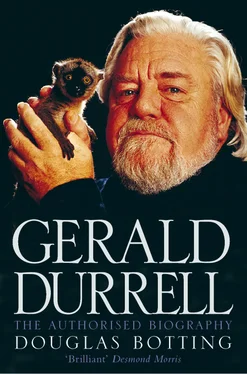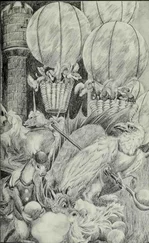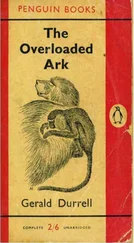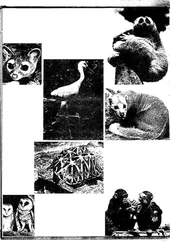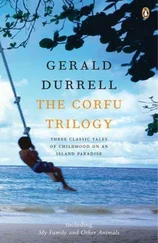Gerald and John had originally planned to sail on 24 June, but their collection had grown so huge that the crates and boxes – five hundred cubic feet in volume – would not fit into the hold of the ship they had booked, and it sailed without them. Eventually they were able to secure berths and cargo space on a banana boat, the SS Tetela , sailing from the port of Tiko a whole month later, on 25 July, and began to prepare for their departure.
‘You cannot just climb aboard a ship with your animals,’ Gerald pointed out, ‘and expect the cook to feed them.’ A vast hoard of foodstuffs had to be got together, gathered from all over the country, and soon the expedition hut at Kumba resembled a market, with bananas, pawpaws, pineapples, oranges, eggs, sacks of corn, potatoes and beans, and the carcass of a whole bullock strewn across the floor.
It was at this point that Gerald went down with malaria, and lay feverish and ill with a temperature of 103 for a week. The plan was to drive down to Tiko during the night of 24 July, arriving at dawn on the day the ship was due to sail. But when the doctor called on the day before their departure, he was aghast at the idea of Gerald going anywhere. ‘You should be kept in bed for at least a fortnight,’ he thundered. ‘You can’t travel on that ship.’ Otherwise, he bluntly informed the ailing Englishman, he would die.
But Gerald went, alternately sweating and shivering in the cab of the lorry as it ploughed down the mud road through the first rains of the season. A torrential downpour half-drowned the animals as they were being loaded on board at the docks, and though he felt like death Gerald insisted on drying the sodden creatures and giving them their night feed. Then the steward poured him a whisky which, he recalled, ‘could have knocked out a horse’, and he lay down in his cabin convinced he was going to die.
But he didn’t. He was lucky with the weather on the voyage home, and soon began to revive with the fresh sea air. The crew found a playpen for Sue the chimpanzee, and titbits and blankets for any monkey with a sniff or a cough. The only casualty was a mongoose that staged a breakout and jumped overboard.
At 4 p.m. on Tuesday, 10 August 1948, the Tetela tied up at Garston Docks, Liverpool, and Gerald Durrell and John Yealland stepped back on to dry land at the end of their African adventure. They had been away more than seven months, and had brought back nearly two hundred creatures all told – among them ninety-five mammals (including the three angwantibo, forty monkeys, a baby chimp and a giant white mongoose), twelve reptiles and ninety-three rare birds. This cargo was sufficiently exotic to attract the attention of the national press. ‘Awantibos, ahoy!’ cried the headlines. ‘The Awantibo is here today … only once seen alive in a European zoo!’
‘Eventually,’ Gerald was to recall, ‘the last cage was towed away, and the vans bumped their way across the docks through the fine, drifting rain, carrying the animals away to a new life, and carrying us towards the preparations for a new trip.’
The expedition had been an enormous challenge, and had turned out a considerable triumph, putting Gerald Durrell and John Yealland in the front rank of British zoo collectors and field workers, and marking the definitive starting point of Gerald’s spectacular career.
*In pidgin all animals are called ‘beef’. There are four kinds: ‘small’, ‘big’, ‘bad’ and ‘bery bad’ beef.
*Spelt ‘Andraia’ in Gerald’s later book. The correct spelling is ‘Andreas’, and the man is still alive.
NINE In the Land of the Fon Second Cameroons Expedition 1948–1949
With the African animals finally settled in their English zoos, and a bit of profit jingling in his pocket, Gerald was free to go home to Bournemouth. He was greeted as if he had come home from the moon, and his residual malaria, diagnosed by Alan Ogden, the family doctor, as the particularly severe strain Plasmodium falciparum , was viewed like a badge of courage brought back from some distant battlefield. Leslie was living with Doris nearby, and Margaret and her children were still in residence at Mother’s house. At Christmas Larry and Eve returned from Argentina and temporarily rejoined the fold.
Gerald was already a very good story-teller, and he held the house in St Alban’s Avenue in thrall with tales of his extraordinary adventures. In the comforting ambience of kith and kin he began to ease up after the strenuous travails of the last year. Slowly – perhaps not so slowly – his mind turned to the long-lost local girlfriends of that far-off pre-Cameroons era of the year before, whose company he had been deprived of for so long during the chaste jungle months. He even thought of taking a holiday – a proposal that provoked an odd reaction. ‘Nothing annoys a collector more,’ he was to recall, ‘than to return after six months of bites, scratches, trouble and toil and to announce to one’s friends that one is thinking of taking a short holiday, only to be told – “But you’ve just had one!”’
It was during Gerald’s brief hometown visit that he encountered a young woman whose equivocal charms were to alternately intrigue and appall him for a long time to come. Her real name was Diane, but he was later to bequeath her the unforgettable nom d’amour of Ursula Pendragon White. His subsequent account of this flawed paragon is intricate and involved, but there is no doubting his fascination with her divine looks and her less than divine language, and the spell cast over him by both. ‘I found,’ he was to recall, ‘that she was the only one who could arouse feelings in me that ranged from alarm and despondency to breathless admiration and sheer horror.’
Ursula was an ex-public school young woman from Canford Cliffs, at the posh end of Bournemouth (though later, to disguise her identity, Gerald was to say she was from Lymington in the New Forest). Gerald first set eyes on her on the top of a double-decker bus in Bournemouth town centre, his attention initially drawn by her ‘dulcet Roedean accents, as penetrating and all-pervading as the song of a roller canary’.
Gerald’s sister Margaret remembered Ursula as ‘a young dolly bird with long blonde hair who sat around in a droopish fashion which was very irritating to the rest of us’. According to Gerald’s later description, though (again, perhaps to disguise her identity), Ursula had dark, curly hair. Her eyes were huge, fringed with long dark lashes and set under very dark eyebrows. ‘Her mouth,’ he recalled, ‘was of the texture and quality that should never, under any circumstances, be used for eating kippers or frogs’ legs or black pudding.’
When Ursula stood up to get off the bus, Gerald saw that she was tall, with long, beautifully shaped legs and ‘one of those willowy, coltish figures that turn young men’s thoughts to lechery’. He reckoned, sighing, that it was unlikely he would ever set eyes on her again. But within three days she was back in his life, and remained so off and on for the next five years.
Encountering her again at a friend’s birthday party, where she greeted him effusively as ‘the bug boy’, Gerald, by his own account, ‘gazed at her and was lost’. It was not just her looks that infatuated him, it was also the sounds she made – ‘her grim, determined, unremitting battle with the English language’. For this svelte and spirited beauty suffered from a sort of oral dyslexia, and was for ever forcing words and phrases to do her bidding, expressing meanings they were never meant to express. There was no guessing what fantastical imagery she would conjure up next. She would speak excitedly of ‘Mozart’s archipelagoes’, of having bulls ‘castigated’, and of ‘ablutions’ to prevent ‘illiterate babies’. In Ursula’s world there was never fire without smoke, and rolling moss gathered no stones. In the prim confines of Bournemouth society ‘she dropped bricks at the rate of an unskilled navvy helping at a building site’.
Читать дальше
